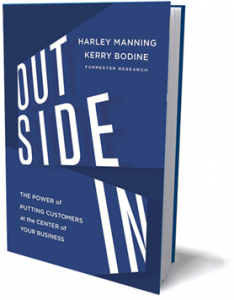 When we think of the companies that we adore and are most loyal to, it’s those that treat us, the customer, with empathy, compassion, and respect. They strive to provide us with the best possible experience anytime we come in contact with them. Harley Manning and Kerry Bodine’s book, Outside In: The Power of Putting Customers at the Center of Your Business, examines leaders in customer experience across industries and points out the common traits that they exhibit both externally and internally. I felt it would be worth reading to see if I could pick up any insights and practices that I could implement in my small business.
When we think of the companies that we adore and are most loyal to, it’s those that treat us, the customer, with empathy, compassion, and respect. They strive to provide us with the best possible experience anytime we come in contact with them. Harley Manning and Kerry Bodine’s book, Outside In: The Power of Putting Customers at the Center of Your Business, examines leaders in customer experience across industries and points out the common traits that they exhibit both externally and internally. I felt it would be worth reading to see if I could pick up any insights and practices that I could implement in my small business.
One of the most important ideas that the book emphasizes, which many businesses seem to forget, is that a business needs its customers more than the customers need the business. It’s a simple statement, but one that is important to establish. In fact, I feel strongly that a business needs to internalize this belief before it will succeed at putting its customers first and delivering an outstanding customer experience.
After establishing this point, Manning and Bodine present numerous case studies and interviews with company executives that demonstrate how companies are succeeding by focusing on the customer experience. Using the case studies, they establish the six disciplines required to deliver a customer experience that will make a company stand above its competition:
- Strategy
- Customer Understanding
- Design
- Measurement
- Governance
- Culture
Implementing these disciplines requires significant effort. Because of that, I felt the book was directed more toward managers, directors, and high-level executives at established companies with revenues of $100MM and above. The recommendations for following these disciplines require staffing and financial resources to implement that are not available to most small businesses and startups. However, there was one exception that I felt business of all sizes could embrace, which was the discipline of culture.
No matter what size a company is, a culture of putting customers at the forefront of your business can be done no matter what size company you are managing or working in. It’s a concept that has to be embraced by the organization’s leadership and implemented from the top down. As the company grows, it will make it much easier to implement the other disciplines if the leadership has instilled the right culture with the company’s first employees. In addition, the leadership cannot compromise on these ideals as the company expands, whether its through hiring practices, policy creation and/or reward systems.
On the other hand, as with any business book, there were points I didn’t agree with 100%.
First, I felt that the authors put a heavy emphasis on customer surveys. Given my first hand experience with customer surveys, I don’t feel these are a tool that most companies know how to use properly. They are often poorly designed (i.e., too many questions and rating options) and used for punishment instead of improvement. It lends itself to employees trying to game the system rather than using it to reveal areas of improvement. In my view, other metrics such as repeat purchases, customer retention rates, and service/product usage are more meaningful since they are a reflection of a customer’s actions rather than their words.
Second, the call to establish yet another C-level executive for Customer Experience, the Chief Customer Officer, is overplayed. It seems like the solution to any business issue these days is to create another C-level officer to handle it. I understand that visibility, accountability and consistency across the organization is important, but aren’t there other ways to achieve it? As the company’s leader, the CEO should be able to get his existing team on board with the importance of putting the customer first. He should be able to nominate one of his reports to lead the initiative and to be held accountable for its implementation. In a smaller organization I would envision the CEO leading the initiative, while a larger organization might have the COO or CMO take the lead.
In any case, I wouldn’t let these concerns detract from the message of the book. While I wouldn’t consider it a must read, it’s a good business book. I agree with the authors that the power of putting customers first is a differentiator that leads to success. Customers have too many resources at their disposal through the internet that allow them to research and rate companies to risk delivering poor service. It’s also easy for them to change to competitors given the global nature of competition that the internet has enabled. Therefore, those companies who provide a superior customer experience will succeed. It’s a practice I’m implementing in my business to establish a competitive advantage, and one that I hope will ultimately lead to success for both me and my customers.

Pingback: My 2014 reading goals and list | Gregg Borodaty